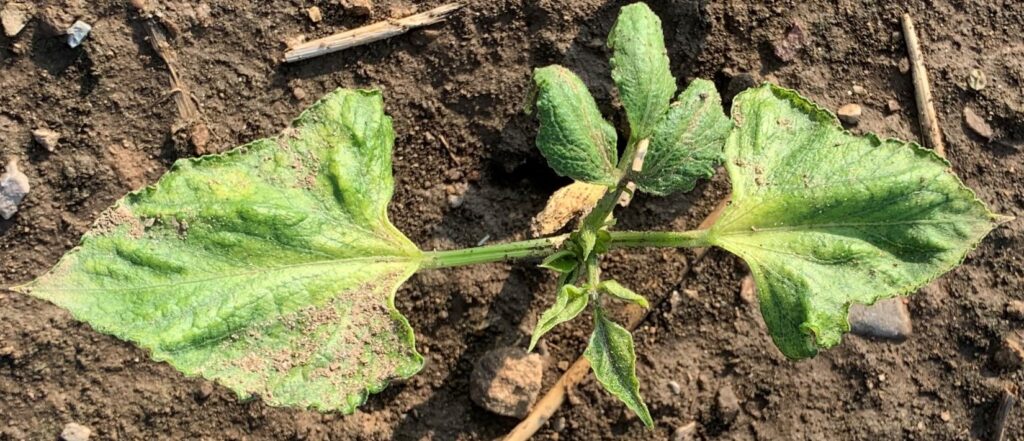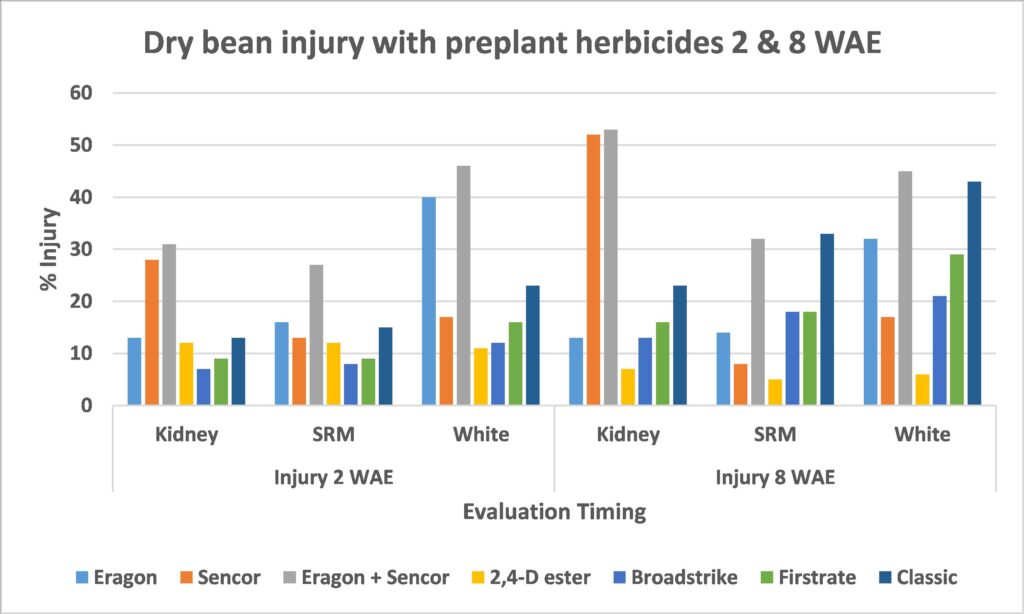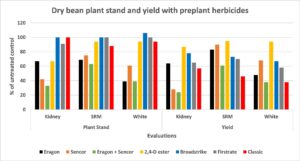No-till, strip-till and minimum tillage practices are becoming more common in dry bean production. Under these systems there are emerging weed management challenges such as glyphosate resistant (GR) Canada fleabane. The challenge of GR Canada fleabane control is well known to soybean producers throughout the province of Ontario. There are a number of herbicide options available to soybean growers to manage this weed. It is critical to identify options for dry bean producers so they can continue to adopt sustainable soil management practices that protect soil and water resources in Ontario.
Eragon, Sencor, Eragon plus Sencor and 2,4-D ester applied preplant (PP) are commonly used to manage GR Canada fleabane in soybean. These herbicides are not registered for use in dry common bean (Phaseolus vulgaris) in Ontario. Information on dry bean tolerance to these herbicides with a PP application is limited.
Evaluations
Four trials were conducted between 2016 and 2017 at the Huron Research Station to evaluate kidney, small red and white bean tolerance to Eragon (59 ml/ac), Sencor (431 g/ac), Eragon (59 ml/ac) plus Sencor (431 g/ac), 2,4-D ester (653 ml/ac), Broadstrike (71 g/ac), FirstRate (34 g/ac) and Classic (29 g/ac) applied PP. Rates evaluated were twice the label rate used in soybean for GR Canada fleabane control to simulate a spray overlap and ensure adequate dry bean tolerance. Strip-till trials were set up with strips being established the previous fall. Trials were maintained weed-free season long. Assessments included crop injury 1, 2, 4 and 8 weeks after bean emergence (WAE), bean plant stand and biomass 3 WAE, bean height 6 WAE and bean yield.
Results – Crop injury
Dry bean injury symptoms included delayed emergence, stand reduction, growth reduction, leaf strapping, chlorosis and necrosis.

Eragon: Dry bean injury from Eragon 2 WAE ranged from 13 to 40% with white bean the most sensitive. Injury was similar at 8 WAE with only a slight decrease. Plant stand was reduced by 31 to 61%. Yield reductions ranged from 17 to 52% with white bean the most sensitive to Eragon applications. Dry common bean does not have adequate tolerance to Eragon applied PP.
Sencor: Dry bean injury from Sencor ranged from 13 to 28% with kidney bean showing the greatest injury 2 WAE. At 8 WAE injury in kidney bean increased to 52% while injury in small red bean declined to 8% and remained at 17% in white bean. Plant stand reductions ranged from 25 to 58% and yield reductions ranging from 10 to 72%. Kidney bean is extremely sensitive to Sencor applications. Dry common bean does not have adequate tolerance to Sencor applied PP.

Eragon plus Sencor: All three dry bean market classes were very sensitive to the tankmix of Eragon plus Sencor with injury ranging from 27 to 46% 2 WAE. Injury did not decline with time and increased to 53% in kidney bean 8 WAE. Plant stand reductions ranged from 37 to 67% and yield reductions ranged from 39 to 76%. Kidney bean was the most sensitive to the tankmix of Eragon plus Sencor. Dry common bean does not have adequate tolerance to the tankmix of Eragon plus Sencor applied PP.
2,4-D ester: Dry bean injury with 2,4-D ester applied PP ranged from 11 to 12% 2WAE and declined to 5 to 7% 8 WAE. Kidney bean plant stand was reduced 33% and yield reduced 23%. There was no commercially significant reduction in plant stand or yield in small red or white bean. 2,4-D ester shows promise as a PP herbicide option in dry common bean.

Broadstrike: Dry bean injury from Broadstrike applied PP ranged from 7 to 12% evaluated 2 WAE increasing to 13 to 21% at 8 WAE. Broadstrike did not reduce plant stand in kidney, small red or white bean. Yield reductions were similar across market classes with reductions of 22 to 33%. Dry common bean does not have adequate tolerance to a PP application of Broadstrike.
FirstRate: Dry bean injury from FirstRate applied PP ranged from 9 to 16% evaluated 2 WAE increasing to 16 to 29% at 8 WAE. FirstRate reduced kidney bean plant stand 9% but did not reduce stand of small red or white bean. Yield reductions ranged from 30 to 42% with white bean being the most sensitive to a PP application of FirstRate. Dry common bean does not have adequate tolerance to a PP application of FirstRate.
Classic: Dry bean injury from Classic applied PP ranged from 13 to 23% evaluated 2 WAE increasing to 23 to 43% at 8 WAE. Classic did not reduce kidney bean plant stand but reduced stand of small red and white bean 12 and 6%, respectively. Yield reductions ranged from 43 to 62% with white bean the most sensitive to a PP application of Classic. Dry common bean does not have adequate tolerance to a PP application of Classic.
Conclusions
Dry common bean does not have adequate tolerance to PP applications of Eragon, Sencor, Eragon plus Sencor, Broadstrike, FirstRate or Classic. Do not use these herbicides for control of GR Canada fleabane in dry bean.
2,4-D ester shows promise as a PP herbicide option for control of GR Canada fleabane in dry common bean. This product is not registered for use in dry beans and growers should always follow label directions. Some export markets may have restrictions on MRLs for unregistered products, and detection of residues could significantly impact trade.
For further information please contact Peter Sikkema (psikkema@uoguelph.ca) or Todd Cowan (tcowan@uoguelph.ca)
This article was written by Todd Cowan and Peter Sikkema.